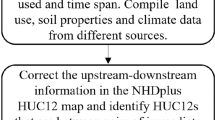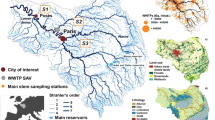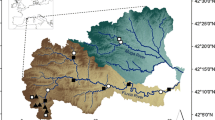Abstract
The ongoing recovery of beaver populations across the boreal biome of North America entails an increasing proliferation of beaver ponds in aquatic networks. Ecosystem-scale studies have demonstrated that beaver ponds are hotspots of carbon dioxide (CO2) and methane (CH4) production. However, beaver pond carbon (C) emissions have rarely been incorporated into estimates of inland water C budgets. Therefore, this potentially represents a major source of uncertainty for the C budget of the boreal biome. In this study, we combined a detailed geospatial analysis with measured CO2 and CH4 diffusive and ebullitive emission rates to estimate beaver pond total C emissions and incorporated these into a whole-aquatic network assessment. We carried out this study in a boreal watershed (13,105 km2) located in Québec, Canada. Our results show that beaver ponds covered 77 km2, representing 9% of the total aquatic surface area in the watershed. We estimate that beaver ponds contribute 7% of the total C emissions from the aquatic network and are responsible for 6% and 18% of the total CO2 and CH4 emitted annually, respectively. We project that by 2055, beaver pond CO2 and CH4 emissions for the same watershed may increase 17% and 56%, respectively, due to a combination of expanding beaver habitat and increasing temperatures. Our results highlight the role of beaver ponds not only in current aquatic CH4 emissions but also as a positive feedback loop for climate change, with significant radiative forcing potential given a scenario of climate warming and beaver population growth.






Similar content being viewed by others
Data availability
References
Bastviken D, Cole J, Pace M, Tranvik L. 2004. Methane emissions from lakes: dependence of lake characteristics, two regional assessments, and a global estimate. Glob Biogeochem Cycles 18:GB4009.
Bastviken D, Tranvik LJ, Downing JA, Crill PM, Enrich-Prast A. 2011. Freshwater methane emissions offset the continental carbon sink. Science 331:50–50.
Battin TJ, Luyssaert S, Kaplan LA, Aufdenkampe AK, Richter A, Tranvik LJ. 2009. The boundless carbon cycle. Nature Geosci 2:598.
Bockstoce JR. 2009. Furs and frontiers in the far North: the contest among Native and foreign nations for the Bering Strait fur trade. New Haven: Yale University Press.
Bubier J, Moore T, Roulet N. 1993. Methane emissions from wetlands in the midboreal region of northern Ontario, Canada. Ecology 74:2240–54.
Butler DR, Malanson GP. 1995. Sedimentation rates and patterns in beaver ponds in a mountain environment. Geomorphology 13:255–69.
Butler DR, Malanson GP. 2005. The geomorphic influences of beaver dams and failures of beaver dams. Geomorphology 71:48–60.
Campeau A, del Giorgio PA. 2014. Patterns in CH4 and CO2 concentrations across boreal rivers: major drivers and implications for fluvial greenhouse emissions under climate change scenarios. Glob Change Biol 20:1075–88.
Campeau A, Lapierre JF, Vachon D, del Giorgio PA. 2014. Regional contribution of CO2 and CH4 fluxes from the fluvial network in a lowland boreal landscape of Québec. Glob Biogeochem Cycles 28:57–69.
Casas-Ruiz JP, Hutchins RH, del Giorgio PA. 2021. Total aquatic carbon emissions across the boreal biome of Québec driven by watershed slope. J Geophys Res Biogeosci 126:e2020JG005863.
Cazzolla Gatti R, Callaghan TV, Rozhkova-Timina I, Dudko A, Lim A, Vorobyev SN, Kirpotin SN, Pokrovsky OS. 2018. The role of Eurasian beaver (Castor fiber) in the storage, emission and deposition of carbon in lakes and rivers of the River Ob flood plain, western Siberia. Sci Total Environ 644:1371–9.
Cole JJ, Prairie YT, Caraco NF, McDowell WH, Tranvik LJ, Striegl RG, Duarte CM, Kortelainen P, Downing JA, Middelburg JJ, Melack J. 2007. Plumbing the global carbon cycle: integrating inland waters into the terrestrial carbon budget. Ecosystems 10:172–85.
Congalton RG, Green K. 2019. Assessing the accuracy of remotely sensed data: principles and practices. Cambridge: CRC Press.
Cooley SW, Smith LC, Stepan L, Mascaro J. 2017. Tracking dynamic northern surface water changes with high-frequency planet CubeSat imagery. Remote Sens 9:1306.
Crawford JT, Lottig NR, Stanley EH, Walker JF, Hanson PC, Finlay JC, Striegl RG. 2014. CO2 and CH4 emissions from streams in a lake-rich landscape: patterns, controls, and regional significance. Glob Biogeochem Cycles 28:197–210.
Cunningham JM, Calhoun AJ, Glanz WE. 2006. Patterns of beaver colonization and wetland change in Acadia National Park. Northeast Nat 13:583–96.
DelSontro T, Beaulieu JJ, Downing JA. 2018. Greenhouse gas emissions from lakes and impoundments: upscaling in the face of global change. Limnol Oceanogr Lett 3:64–75.
DelSontro T, Boutet L, St-Pierre A, del Giorgio PA, Prairie YT. 2016. Methane ebullition and diffusion from northern ponds and lakes regulated by the interaction between temperature and system productivity. Limnol Oceanogr 61:S62–77.
Denfeld BA, Baulch HM, del Giorgio PA, Hampton SE, Karlsson J. 2018. A synthesis of carbon dioxide and methane dynamics during the ice-covered period of northern lakes. Limnol Oceanogr Lett 3:117–31.
Desrosiers K, DelSontro T, del Giorgio PA. 2022. Disproportionate contribution of vegetated habitats to the CH4 and CO2 budgets of a boreal lake. Ecosystems 25:1522–41.
Dove A, Roulet N, Crill P, Chanton J, Bourbonniere R. 1999. Methane dynamics of a northern boreal beaver pond. Ecoscience 6:577–86.
Downing JA. 2010. Emerging global role of small lakes and ponds: little things mean a lot. Limnetica 29:0009–24.
Downing JA, Prairie Y, Cole J, Duarte C, Tranvik L, Striegl RG, McDowell W, Kortelainen P, Caraco N, Melack J. 2006. The global abundance and size distribution of lakes, ponds, and impoundments. Limnol Oceanogr 51:2388–97.
Ecke F, Levanoni O, Audet J, Carlson P, Eklöf K, Hartman G, McKie B, Ledesma J, Segersten J, Truchy A, Futter M. 2017. Meta-analysis of environmental effects of beaver in relation to artificial dams. Environ Res Lett 12:113002.
Fairfax E, Small EE. 2018. Using remote sensing to assess the impact of beaver damming on riparian evapotranspiration in an arid landscape. Ecohydrology 11:e1993.
Ford TE, Naiman RJ. 1988. Alteration of carbon cycling by beaver: methane evasion rates from boreal forest streams and rivers. Can J Zool 66:529–33.
Gorelick N, Hancher M, Dixon M, Ilyushchenko S, Thau D, Moore R. 2017. Google earth engine: planetary-scale geospatial analysis for everyone. Remote Sens Environ 202:18–27.
Gurnell AM. 1998. The hydrogeomorphological effects of beaver dam-building activity. Prog Phys Geogr 22:167–89.
He H, Moore T, Humphreys ER, Lafleur PM, Roulet NT. 2023. Water level variation at a beaver pond significantly impacts net CO2 uptake of a continental bog. Hydrol Earth Syst Sci 27:213–27.
Holgerson MA, Raymond PA. 2016. Large contribution to inland water CO2 and CH4 emissions from very small ponds. Nat Geosci 9:222–6.
Huertas Herrera A, Lencinas MV, Toro Manríquez M, Miller JA, Martínez Pastur G. 2020. Mapping the status of the North American beaver invasion in the Tierra del Fuego archipelago. PLoS ONE 15:e0232057.
Hutchins RH, Casas-Ruiz JP, Prairie YT, del Giorgio PA. 2020. Magnitude and drivers of integrated fluvial network greenhouse gas emissions across the boreal landscape in Québec. Water Res 173:115556.
Huttunen JT, Alm J, Liikanen A, Juutinen S, Larmola T, Hammar T, Silvola J, Martikainen PJ. 2003. Fluxes of methane, carbon dioxide and nitrous oxide in boreal lakes and potential anthropogenic effects on the aquatic greenhouse gas emissions. Chemosphere 52:609–21.
Jarema SI. 2008. The abundance and distribution of beavers (Castor canadensis) in Québec, Canada: ProQuest.
Jarema SI, Samson J, McGill BJ, Humphries MM. 2009. Variation in abundance across a species’ range predicts climate change responses in the range interior will exceed those at the edge: a case study with North American beaver. Glob Change Biol 15:508–22.
Johnston CA. 2014. Beaver pond effects on carbon storage in soils. Geoderma 213:371–8.
Johnston CA, Naiman RJ. 1987. Boundary dynamics at the aquatic-terrestrial interface: the influence of beaver and geomorphology. Landsc Ecol 1:47–57.
Johnston CA, Naiman RJ. 1990. The use of a geographic information system to analyze long-term landscape alteration by beaver. Landsc Ecol 4:5–19.
Jones BM, Tape KD, Clark JA, Nitze I, Grosse G, Disbrow J. 2020. Increase in beaver dams controls surface water and thermokarst dynamics in an Arctic tundra region, Baldwin Peninsula, northwestern Alaska. Environ Res Lett 15:075005.
Juutinen S, Rantakari M, Kortelainen P, Huttunen J, Larmola T, Alm J, Silvola J, Martikainen P. 2009. Methane dynamics in different boreal lake types. Biogeosciences 6:209–23.
Kankaala P, Huotari J, Tulonen T, Ojala A. 2013. Lake-size dependent physical forcing drives carbon dioxide and methane effluxes from lakes in a boreal landscape. Limnol Oceanogr 58:1915–30.
Lazar JG, Addy K, Welsh MK, Gold AJ, Groffman PM. 2014. Resurgent beaver ponds in the northeastern United States: implications for greenhouse gas emissions. J Environ Qual 43:1844–52.
McFeeters SK. 1996. The use of the Normalized Difference Water Index (NDWI) in the delineation of open water features. Int J Remote Sens 17:1425–32.
Messager ML, Lehner B, Grill G, Nedeva I, Schmitt O. 2016. Estimating the volume and age of water stored in global lakes using a geo-statistical approach. Nat Commun 7:1–11.
Myhre G, Shindell D, Pongratz J. 2013. Anthropogenic and natural radiative forcing. In, Climate Change 2013: The Physical Science Basis. Contribution of Working Group I to the Fifth Assessment Report of the Intergovernmental Panel on Climate Change, edited by T. F. Stocker et al., pp. 659–740, Cambridge Univ. Press, Cambridge, U. K., and New York
Naiman RJ, Johnston CA, Kelley JC. 1988. Alteration of North American streams by beaver. BioScience 38:753–62.
Naiman RJ, Manning T, Johnston CA. 1991. Beaver population fluctuations and tropospheric methane emissions in boreal wetlands. Biogeochemistry 12:1–15.
Naiman RJ, Melillo JM, Hobbie JE. 1986. Ecosystem alteation of boreal forest streams by beaver (Castor canadensis). Ecology 67:1254–69.
Nyssen J, Pontzeele J, Billi P. 2011. Effect of beaver dams on the hydrology of small mountain streams: example from the Chevral in the Ourthe Orientale basin, Ardennes, Belgium. J Hydrol 402:92–102.
Olthof I, Fraser RH, Schmitt C. 2015. Landsat-based mapping of thermokarst lake dynamics on the Tuktoyaktuk Coastal Plain, Northwest Territories, Canada since 1985. Remote Sens Environ 168:194–204.
Otsu N. 1979. A threshold selection method from gray-level histograms. IEEE Trans Syst Man Cybern 9:62–6.
Peacock M, Audet J, Bastviken D, Cook S, Evans C, Grinham A, Holgerson M, Högbom L, Pickard A, Zieliński P. 2021. Small artificial waterbodies are widespread and persistent emitters of methane and carbon dioxide. Glob Change Biol 27:5109–23.
Pearl CA, Adams MJ, Haggerty PK, Urban L. 2015. Using occupancy models to accommodate uncertainty in the interpretation of aerial photograph data: status of beaver in Central Oregon, USA. Wildl Soc Bull 39:319–25.
Rasilo T, Prairie YT, del Giorgio PA. 2015. Large-scale patterns in summer diffusive CH4 fluxes across boreal lakes, and contribution to diffusive C emissions. Glob Change Biol 21:1124–39.
Richardson DC, Holgerson MA, Farragher MJ, Hoffman KK, King K, Alfonso MB, Andersen MR, Cheruveil KS, Coleman KA, Farruggia MJ, Fernandez LR, Hondula KL, López Moreira Mazacotte GA, Paul K, Peierls BL, Rabaey JS, Sadro S, Sánchez ML, Smyth RL, Sweetman JN. 2022. A functional definition to distinguish ponds from lakes and wetlands. Sci Rep 12:1–13.
Rosell F, Bozser O, Collen P, Parker H. 2005. Ecological impact of beavers Castor fiber and Castor canadensis and their ability to modify ecosystems. Mamm Rev 35:248–76.
Rosentreter JA, Borges AV, Deemer BR, Holgerson MA, Liu S, Song C, Melack J, Raymond PA, Duarte CM, Allen GH, Olefeldt D, Poulter B, Battin TI, Eyre BD. 2021. Half of global methane emissions come from highly variable aquatic ecosystem sources. Nat Geosci 14:225–30.
Roulet NT, Crill P, Comer N, Dove A, Boubonniere R. 1997. CO2 and CH4 flux between a boreal beaver pond and the atmosphere. J Geophys Res Atmos 102:29313–9.
St-Pierre ML, Labbé J, Darveau M, Imbeau L, Mazerolle MJ. 2017. Factors affecting abundance of beaver dams in forested landscapes. Wetlands 37:941–9.
Swift TP, Kennedy LM. 2021. Beaver-driven peatland ecotone dynamics: impoundment detection using lidar and geomorphon analysis. Land 10:1333.
Tape KD, Jones BM, Arp CD, Nitze I, Grosse G. 2018. Tundra be dammed: beaver colonization of the Arctic. Glob Change Biol 24:4478–88.
Team RC. 2013. R Core Team: a language and environment for statistical computing R Foundation for Statistical Computing. Vienna, Austria.
Traganos D, Cerra D, Reinartz P. 2017. Cubesat-derived detection of seagrasses using planet imagery following unmixing-based denoising: Is small the next big? Int Arch Photogramm Remote Sens Spat Inf Sci ISPRS Arch 42:283–7.
Tranvik LJ, Downing JA, Cotner JB, Loiselle SA, Striegl RG, Ballatore TJ, Dillon P, Finlay K, Fortino K, Knoll LB, Kortelainen PL, Kutser T, Larsen S, Laurion I, Leech DM, McCallister SL, McKnight DM, Melack J, Overholt E, Porter JA, Prairie Y, Renwick WH, Roland F, Sherman BS, Schindler DW, Sobek S, Tremblay A, Vanni MJ, Verschoor AM, Von Wachenfeldt E, Weyhenmeyer G. 2009. Lakes and reservoirs as regulators of carbon cycling and climate. Limnol Oceanogr 54:2298–314.
Vachon D, Prairie YT, Cole JJ. 2010. The relationship between near-surface turbulence and gas transfer velocity in freshwater systems and its implications for floating chamber measurements of gas exchange. Limnol Oceanogr 55:1723–32.
Verpoorter C, Kutser T, Seekell DA, Tranvik LJ. 2014. A global inventory of lakes based on high-resolution satellite imagery. Geophys Res Lett 41:6396–402.
Weyhenmeyer CE. 1999. Methane emissions from beaver ponds: rates, patterns, and transport mechanisms. Glob Biogeochem Cycles 13:1079–90.
Whitfield CJ, Baulch HM, Chun KP, Westbrook CJ. 2015. Beaver-mediated methane emission: the effects of population growth in Eurasia and the Americas. Ambio 44:7–15.
Wik M, Varner RK, Anthony KW, MacIntyre S, Bastviken D. 2016. Climate-sensitive northern lakes and ponds are critical components of methane release. Nat Geosci 9:99–105.
Wohl E. 2013. Landscape-scale carbon storage associated with beaver dams. Geophys Res Lett 40:3631–6.
Yavitt J, Lang G, Sexstone A. 1990. Methane fluxes in wetland and forest soils, beaver ponds, and low-order streams of a temperate forest ecosystem. J Geophys Res Atmos 95:22463–74.
Yavitt JB, Fahey TJ. 1994. Beaver impoundments in temperate forests as sources of atmospheric CO2. Geophys Res Lett 21:995–8.
Yvon-Durocher G, Allen AP, Bastviken D, Conrad R, Gudasz C, St-Pierre A, Thanh-Duc N, del Giorgio PA. 2014. Methane fluxes show consistent temperature dependence across microbial to ecosystem scales. Nature 507:488–91.
Acknowledgements
We thank the authorities of the l’Institut de recherche sur les forêts of the Université du Québec en Abitibi-Témiscamingue (UQAT) for access to the Lac Duparquet Research Station. We thank Margaret Kalacska of the McGill Department of Geography for guidance with the geospatial analysis, and Emily Fairfax for advice on uncertainty calculations. We also thank Alice Parkes for coordinating laboratory analyses and data processing, Roy Nahas for GIS analyses, Michela de Melo for the contribution to accuracy assessments, and all the members of CarBBAS team, including undergraduate summer students, who participated in the various field campaigns over the course of the study. This work is part of the research program of the CarBBAS (Carbon Biogeochemistry in Boreal Aquatic Systems) Research program, co-funded by the Natural Sciences and Engineering Research Council of Canada and Hydro-Québec (NSERC Grant #592000).
Author information
Authors and Affiliations
Corresponding author
Additional information
Author Contributions: All authors contributed to the study design, data analysis, and writing of manuscript. Annick St-Pierre and Paul A. del Giorgio conducted field work.
Supplementary Information
Below is the link to the electronic supplementary material.
Rights and permissions
Springer Nature or its licensor (e.g. a society or other partner) holds exclusive rights to this article under a publishing agreement with the author(s) or other rightsholder(s); author self-archiving of the accepted manuscript version of this article is solely governed by the terms of such publishing agreement and applicable law.
About this article
Cite this article
Smufer, F., Casas-Ruiz, J.P., St-Pierre, A. et al. Integrating Beaver Ponds into the Carbon Emission Budget of Boreal Aquatic Networks: A Case Study at the Watershed Scale. Ecosystems 26, 1309–1325 (2023). https://doi.org/10.1007/s10021-023-00835-3
Received:
Accepted:
Published:
Issue Date:
DOI: https://doi.org/10.1007/s10021-023-00835-3




